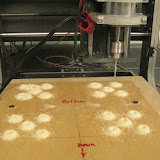At the Joint Statistical Meetings (Aug 2011), accepting the Roger Herriot Award for Innovation in Federal Statistics, I tipped my hat to pen-source software and three mentors. I use the software (R, OpenBUGS, and MediaWiki) every day at work to model contaminant occurrence in drinking water. I use R every month at home to write CNC machine code.
My three mentors are:
- Franklin Smith (Research Triangle Institute, retired) who was the first to gently push me in the direction of mathematical statistics,
- Harvey Gold (North Carolina State Univ, prof emeritus) who brought out the Bayesian in me, and
- Andy Clayton (Research Triangle Institute, retired), who was my go-to statistician, back when I was a simple scientist. Andy is still my model statistician.
The Roger Herriot Award is precented annually by the Government Statistics Section, Social Statistics Section, and The Washington Statistical Ssociety of the American Statistical Association.

























